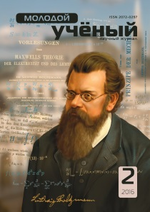Definition: If do reflected![]() , equality
, equality![]() . This reflect is involution.
. This reflect is involution.
Such functions ![]() arrange an involution.
arrange an involution.
The properties of involution is take possession a lot of problem full give at the [1] article.
1. Following
![]() (1)
(1)
Looking the equation. ![]() Free term.
Free term.
Theorem-1: If be ![]() that is involution
that is involution ![]() at the equation (1), then equation (1) limit step after the problem be solved is form second order the equation differential.
at the equation (1), then equation (1) limit step after the problem be solved is form second order the equation differential.
Prove: The equality (1) for be solved, this the is equality the aspect writing
![]()
its differentiated, as a result is form equality
![]()
![]() (2)
(2)
Looking the involution is take notice at the equality (1), exchange the ![]() this
this![]() ,
,
following form equality
![]() (3)
(3)
in accordance the equality (3) and (2)

![]()
The second order, vulgar differential equation integration problem is form
 (4)
(4)
exchanged elementary as a result is property of the involution that equation (1) is solution of problem at the this equation.
2. Following, looking is equation
![]() (5)
(5)
![]() Function,
Function, ![]()
Theorem-2: If be ![]() that is involution
that is involution ![]() at the equation (5), then equation (5) limit step after the problem be solved is form fourth order the equation differential
at the equation (5), then equation (5) limit step after the problem be solved is form fourth order the equation differential
Prove: We have (6) at the equality (5)
![]() (6)
(6)
The equality (6) differential ling sequence twice:
![]()
 ,
,

Above the equality is division ![]()


![]() equality be used at the property of the involution, exchanged
equality be used at the property of the involution, exchanged ![]() we have following equality
we have following equality
![]() (7)
(7)
The ![]() and
and ![]() equates putting off equality (7)
equates putting off equality (7)

Therefore, following bring in put.
![]()
So, make up the result of upper result is simplify s following aspect
 (8)
(8)
Equation (8) we know coming the fourth order, constant coefficient equation differential
3. Following, looking equation
that ![]() function,
function, ![]()
Teorema-3: If be ![]() that is involution
that is involution ![]() at the equation (9), then equation (9) limit step after the problem be solved is form sixth order the equation differential.
at the equation (9), then equation (9) limit step after the problem be solved is form sixth order the equation differential.
Prove: We has![]() (10) at the equation (9).
(10) at the equation (9).
The equality (10) time three is differentia ling sequence:
a) 
b) 
c) 
The property of involution issuing ![]() exchange at the
exchange at the
![]()
Following equality is pass (11)
Above we are find ![]() ,
, ![]() and
and ![]() at the (10) equality, so, that putting equality (11).
at the (10) equality, so, that putting equality (11).
As a result:
 (12)
(12)
The equality constant coefficient sixth order, equality of differential.
References:
- Винер И. Я. Дифференциальные уравнения с инволюциями. // Дифференциальные уравнения. Том 5, 1969.
- Хромов А. П. Смешанная задача для дифференциального уравнения с инволюцией и потенциалом специального вида. // Известия Саратовского университета, Нов.сер. Математика, Механика, Информатика. 2010, т.10, вып № 4, с.17–22.
- Курдюмов В. П., Хромов А. П. О базисах Рисса из собственных и присоединенных функций функционально-дифференциального оператора переменной структуры. //Изв. Сарат.унта. Нов.сер.Математика. Механика. Информатика.2007.Т.7, вып.2, С. 20–25.







